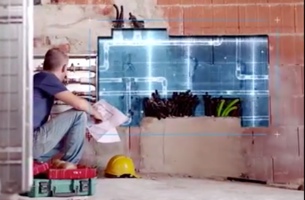Tech startup Vayyar has developed a sensor that uses radio waves to generate 3D images of objects hidden behind obstructions. This week, the company announced that they have raised $22 million in venture capital.
During the presentation Vayyar founder Raviv Melamed mentioned a number of possible uses for the technology, including inspection of hidden utilities like sewage piping, power lines, and so on.
Though the technology was developed as an affordable device for early detection of breast cancer, the sensor has already been used for applications as differing as sense-and-avoid solutions for UAVs and tracking the fat content in milk. Citing the number of applications the sensor has been used for already, Melamed said “the goal was to have a low-cost imaging device that every person can use, instead of just experts and people who understand complex technology.”
The Vayyar sensor can be connected to a phone or computer, which allows developers to create their own devices and applications using Vayyar’s technology.
Perhaps the most interesting possible application of the Vayyar sensor is augmented reality. Since the sensor is small, relatively inexpensive, and can be connected to existing computers, it seems to offer an ideal imaging sensor for augmented reality devices like Microsoft’s HoloLens or Daqri’s Smart Helmet.
Since the sensor’s use of radio waves enables it to see objects hidden by obstructions such as walls, it could be useful for generating digital displays of structural elements, piping, and other objects that are hidden to the eye. Furthermore, the sensor would have an advantage over displaying these objects by drawing data from the original plan, because the sensor would generate a picture of the elements as they were built rather than as they were designed.
Unfortunately, as full details of the sensor have not yet been released, that possibility remains uncertain. Much depends on whether the device can produce images of obstructed objects in real-time, as well as the development of precise location solutions for augmented reality.
If a construction worker cannot be certain that the object their AR headset is showing to them is being displayed in real time and in the exact correct position, it will never see widespread use.
[h/t: TechCrunch]






